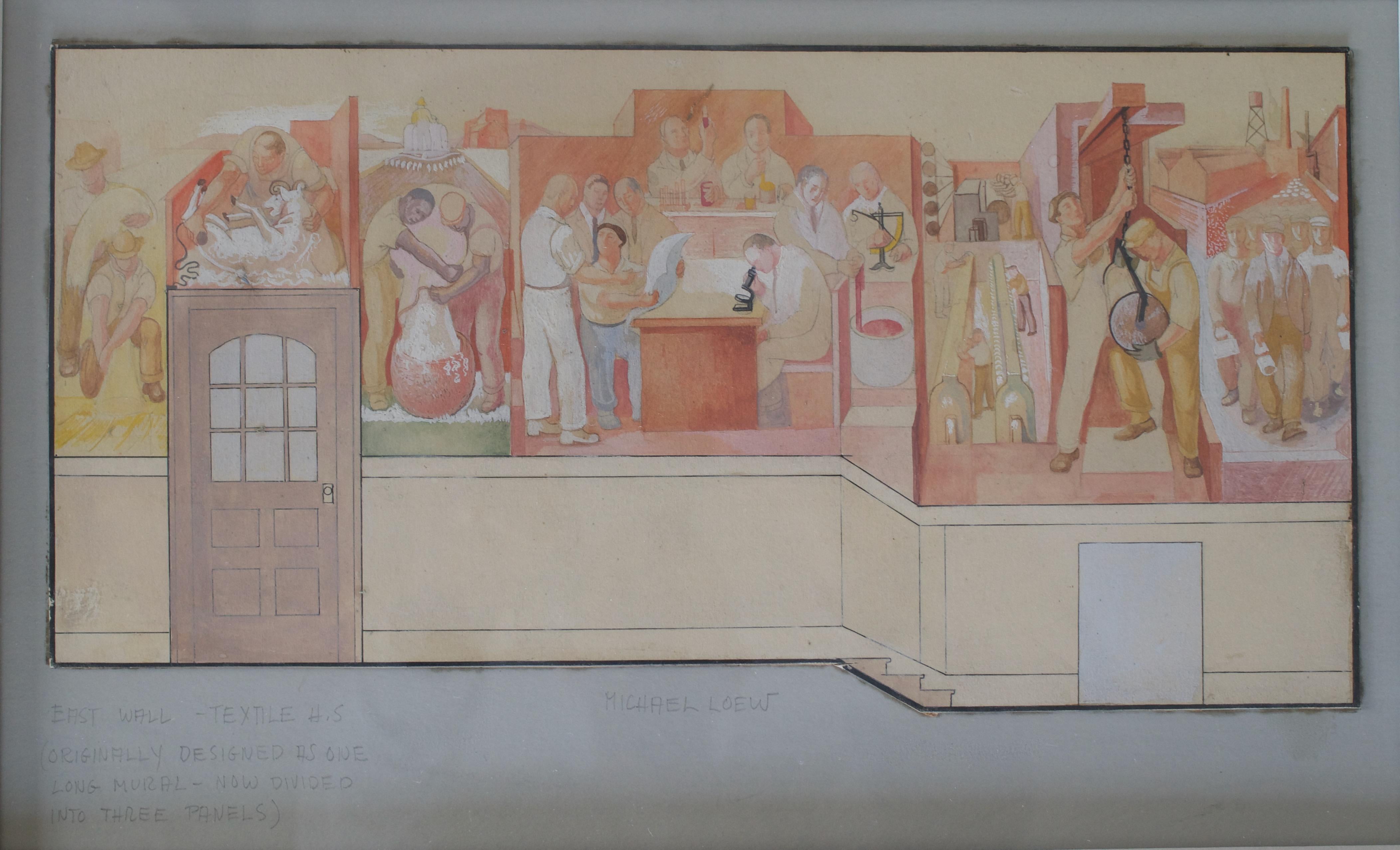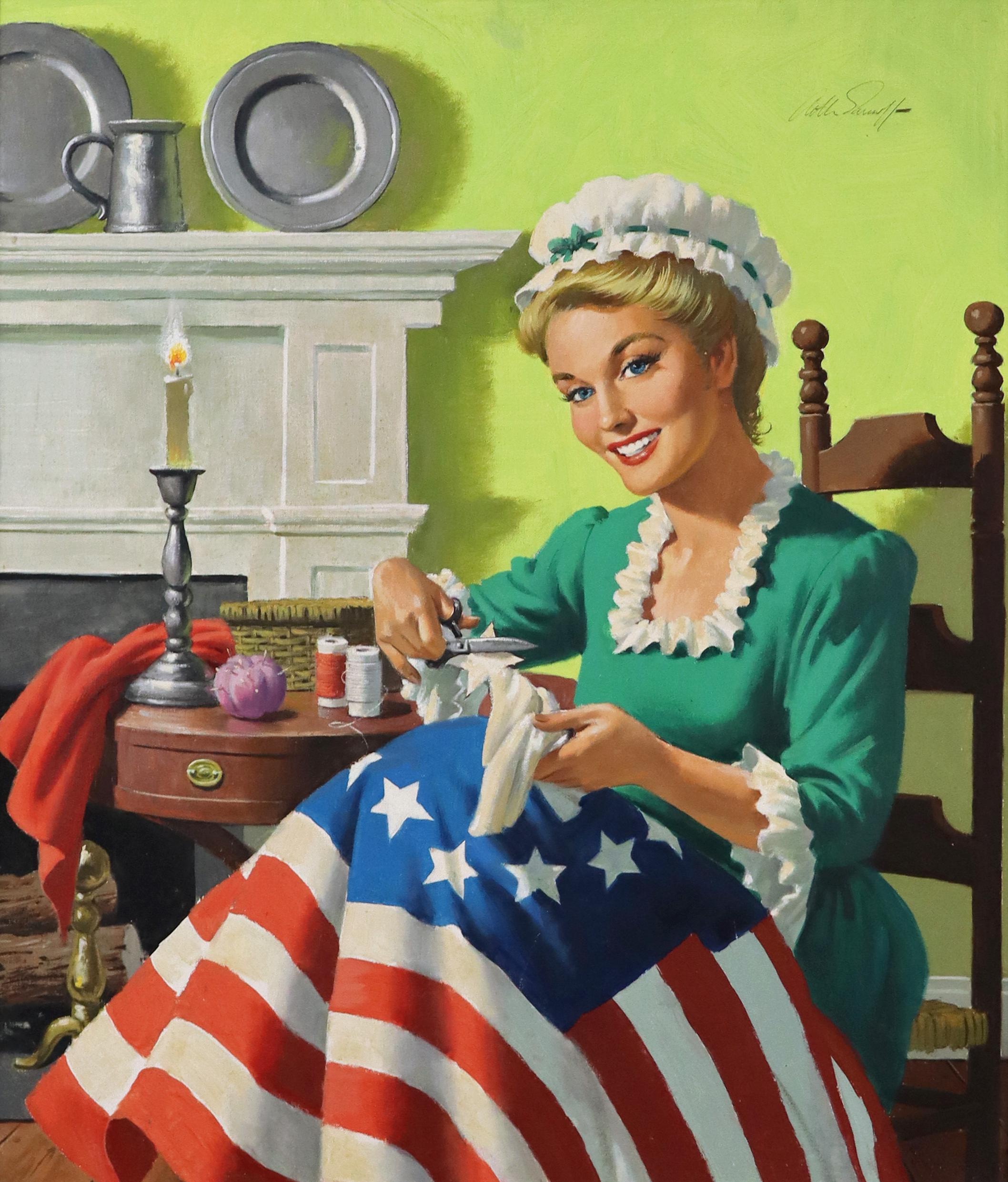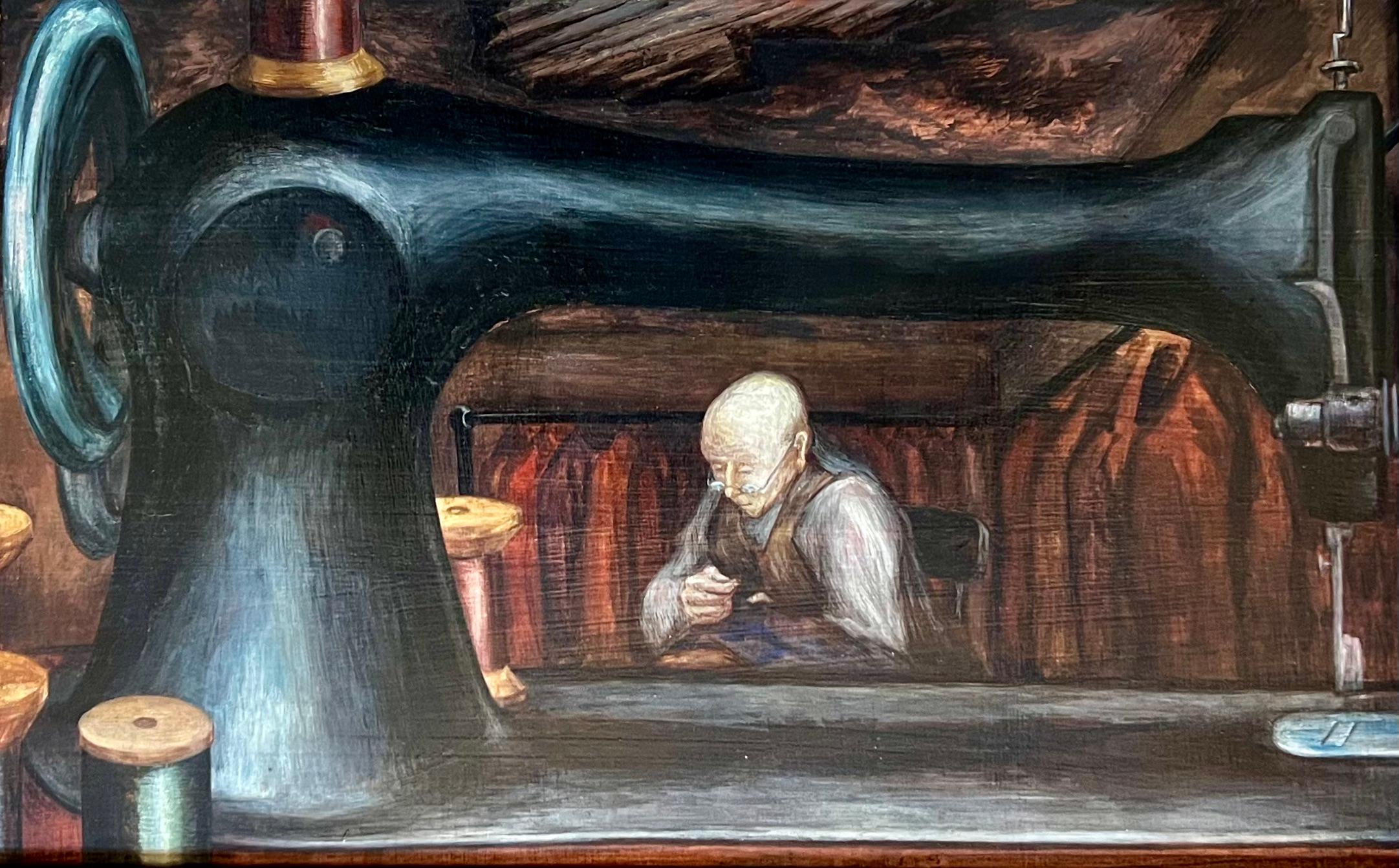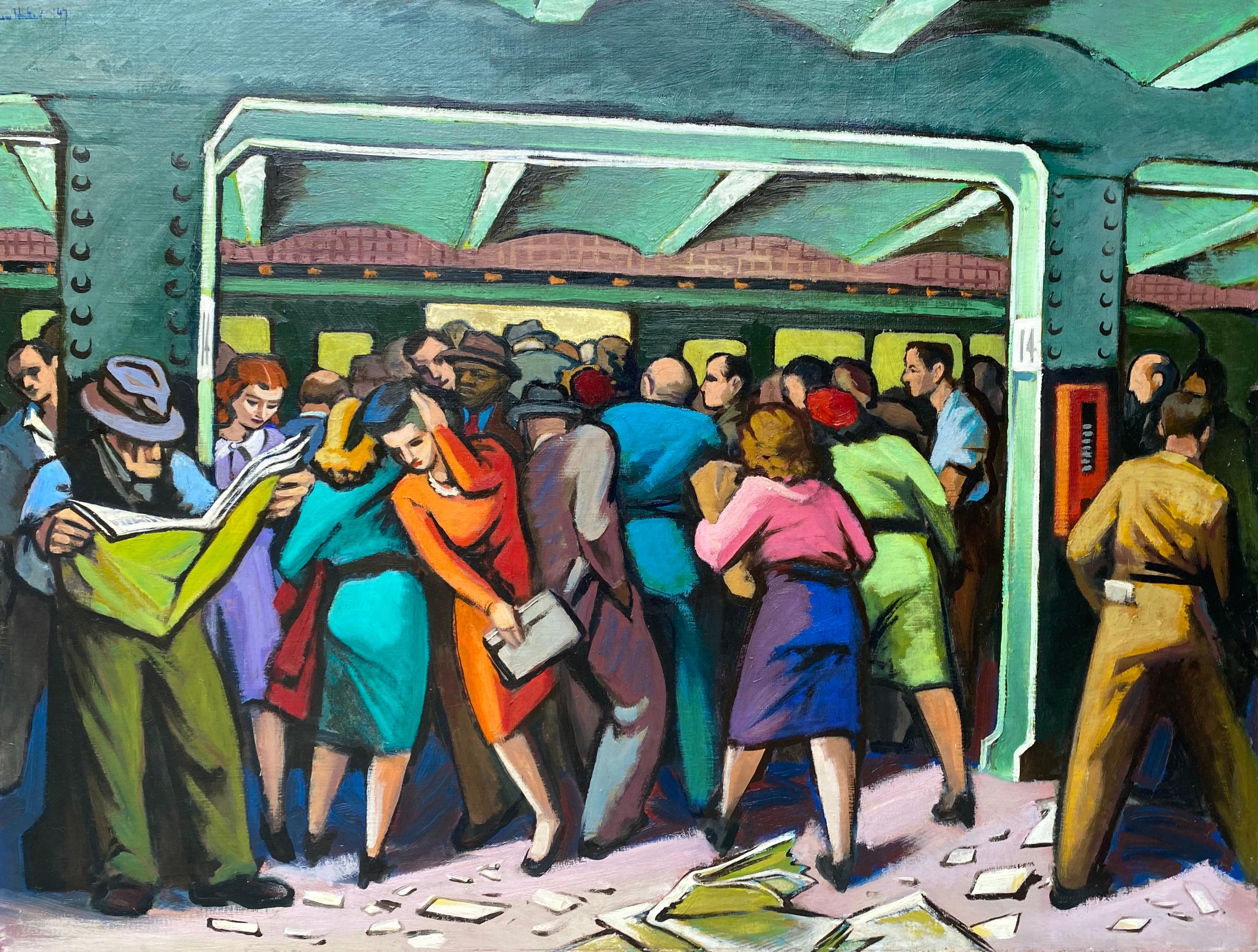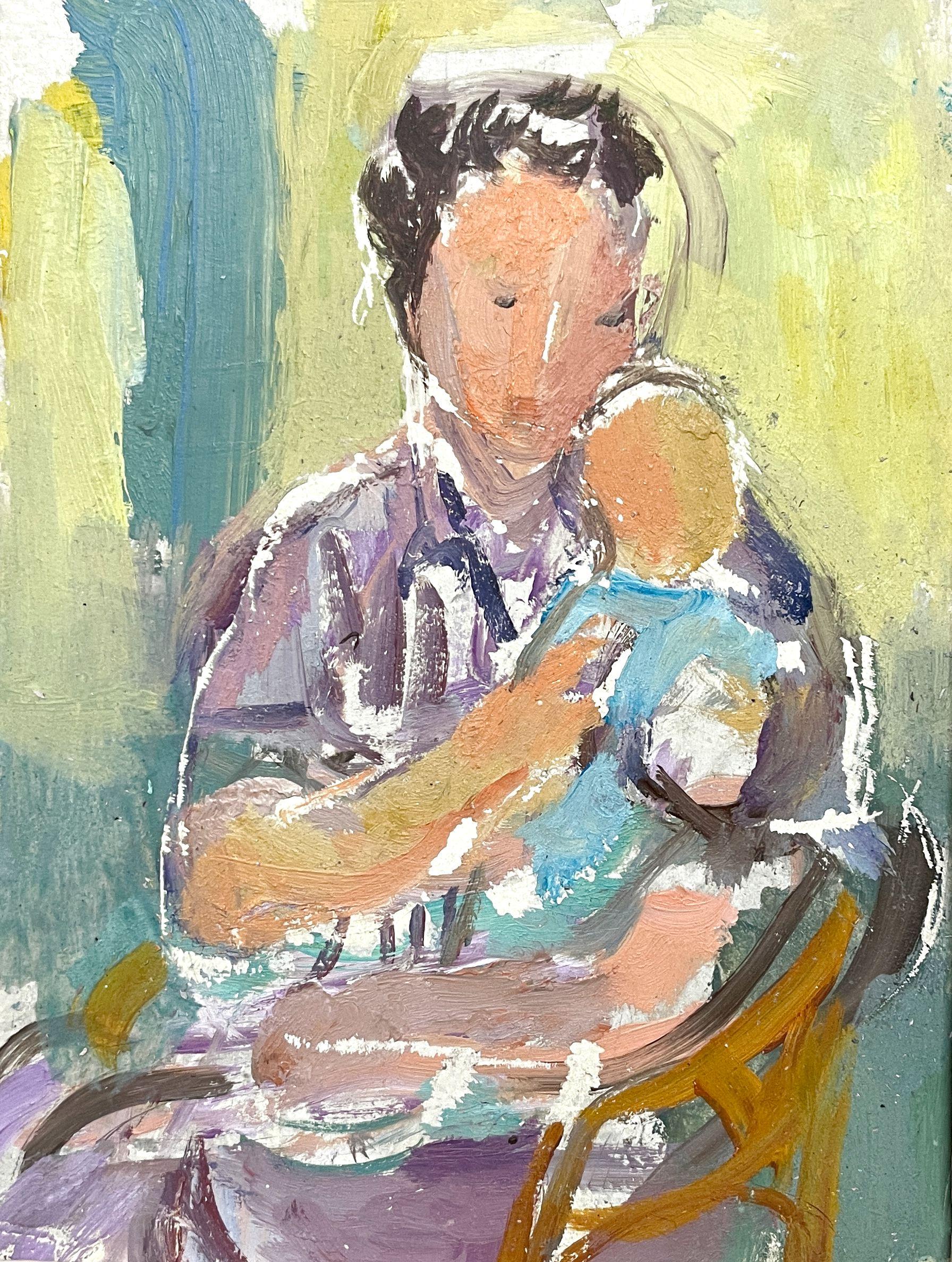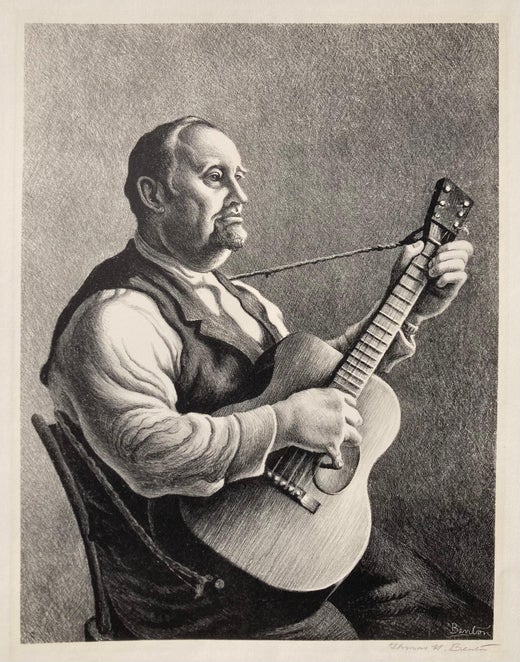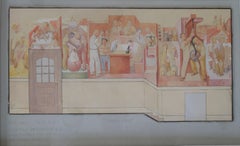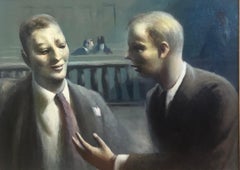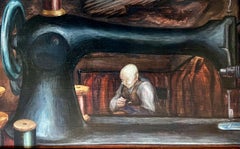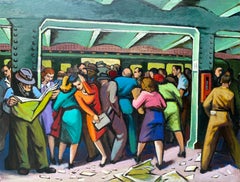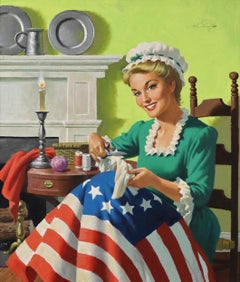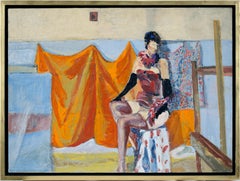Articoli simili a Mural Study for "History of Water" American Scene Modernism Social Realism WPA
Caricamento del video
Vuoi altre immagini o video?
Richiedi altre immagini o video al venditore
1 di 9
Thomas Hart BentonMural Study for "History of Water" American Scene Modernism Social Realism WPA1930
1930
Informazioni sull’articolo
Mural Study for "History of Water" American Scene Modernism Social Realism WPA
Thomas Hart Benton (American, 1889-1975)
"Water Story" (Study for The History of Water)
Tempera and oil on board, 1930
Unsigned
Board: 20 x 18 inches
Sight: 19 x 15 inches
Framed 28 x 24 inches
Footnotes:
Provenance
Donald B. Stegner, New Jersey.
By descent.
A private collection, St. Petersburg, Florida, 1995.
A private collection, Zurich, Switzerland, 2016.
A private collection, Canada.
The painting is a study for Thomas Hart Benton's 1930 mural "The History of Water," which was commissioned for a Washington, D.C., drugstore. "Water Story" also relates to one of the artist's most renowned murals, "America Today," executed for the dining room of the New School for Social Research in New York in 1930/31.
In a deal with the institution's director, Alvin Johnson, Benton agreed to create "America Today" without compensation. Realizing that the artist was financially short, Johnson arranged for a paid commission with a drugstore on 14th Street in Washington, D.C.
Additionally, many of the figures depicted in "Water Story" relate to Benton's next commission, "The Arts of Life in America," which was created for the Whitney Museum of American Art in 1932.
This work will be included in the forthcoming catalogue raisonné being prepared by the Thomas Hart Benton Catalogue Raisonné Foundation.
The History of Water
Written by Dr. Henry Adams, author of “Thomas Hart Benton: An American Original.”
Thomas Hart Benton established his reputation in the 1930s with five mural projects which changed the face of American art and provided the principle artistic model for the WPA mural program. They are generally considered the most important mural projects ever executed in the United States. Four of these projects, have an extensive bibliography and have been widely reproduced in monographs and textbooks on American art. The fifth, "The History of Water," disappeared from sight soon after it was executed, since when the drugstore in Washington D.C. for which it was painted went out of business, it was removed from the wall and placed in the basement, where it sat unnoticed for nearly half a century. It was rediscovered in 1985, when someone noticed that it was signed Benton in black paint at the lower right. After being verified as a long-missing work by Thomas Hart Benton, it was put up for auction at Sotheby’s (sale of December 6, 1984, lot no. 219).
Since Benton’s murals of the 1930s, the group of works most closely related to "The History of Water," have almost all been moved from their original locations I think it’s helpful to list them here.
"The Arts of Life in America," executed for the Whitney Museum of American Art in 1932, currently owned by The New Britain Museum of Art, New Britain, Connecticut.
"A Social History of Indiana," executed for the Indiana Pavilion at the Century of Progress Exposition in Chicago in 1933, currently owned by the University of Indiana, and on view in the History Building and Theater Building.
"A Social History of Missouri," executed for the Missouri State Capitol in Jefferson City in 1935, and still on view there, the only Benton mural of the 1930s which is still in its original location.
While admittedly more modest in scale than the other four murals, several things make "The History of Water" quite notable both historically and artistically: it comes from Benton’s best period, it is exactly contemporary with Benton’s most important mural, "America Today," and relates very closely to it..
The commission for "The History of Water" came about because of Benton’s creation of his first and arguably his great mural, "America Today" for the New School for Social Research in New York, a center of progressive and reform-minded educators (including several figures who had recently been fired from Columbia University, such as Marxist historian Charles Beard).
For nearly a decade Benton had been producing a series of large mural-like history paintings, The American Historical Epic, in the hope that some architect would provide him a wall to paint. In 1930, when Benton was represented by the Delphic Galleries, Alma Reed, who managed the gallery, arranged a commission for her lover Jose Clement Orozco to execute a mural for the dining room of The New School for Social Research, which was being built to design by the modernist Joseph Urban. Outraged that a Mexican should be favored over an American, Benton’s friend Ralph Pierson went to the director of the New School, Alvin Johnson, and arranged a commission for Benton as well – a mural for the building’s board room.
Since there was no budget for such a painting, Benton agreed to execute the project for no pay except for the cost of the materials. As he memorably told Johnson (referring to his egg tempera medium): “I’ll do the mural if you’ll give me the eggs.”
Aware that Benton was hard-up, and obviously embarrassed that he was being financially exploited, Johnson made restitution by arranging another commission for Benton for which he was actually reimbursed: a painting on the theme of "The History of Water" for a drugstore in Washington D.C. It’s unclear where Benton executed the painting, but since it’s too large to have fit in his apartment most likely he either executed it in situ in Washington D.C., or in the very loft-space in New York that Alvin Johnson provided to him for the creation of "America Today."
My belief is that "The History of Water" is almost exactly contemporary with Benton’s last (and best) two panels from the "America Today" mural, City Activities with Subway and City Activities with Dance Hall. Many of the motifs in "The History of Water" are extremely similar to the ones in these two panels and it’s likely that they were based on alternative sketches that Benton had made of the same models. In particular, the background of The History of Water, the soda-fountain scene is extremely similar to America Today, so much so that it almost might be considered an additional scene of the mural.
For example, the woman with a hat and high heels who is sitting on a barstool in "The History of Water" also appears in "City Activities with Subway." She is the well-known burlesque performer Peggy Reynolds, who appears in the subway scene of America Today, where she is being ogled by Max Eastman. In fact, Benton probably used exactly the same drawing for both murals (this drawing is now in the collection of Equitable Life Assurance, which also owns the "America Today" mural).
To prevent this reuse from becoming too obvious, he reversed the direction of the head and changed the color of her hat (from red to gold) and of her dress (from gold to blue).
Most of the other figures are extremely close to those in a similar soda fountain scene on the right hand side of "City Activities with Dance Hall." From Benton’s unpublished memoir, "The Intimate Story," we know that the soda jerk in "America Today" was his friend Leo Huberman, who wrote a Marxist history of the United States, published in 1933, We, the People, which Benton illustrated. The figure in "The History of Water" seems to be the same person, with the same features and hairline, although drawn a little more loosely and equipped with a hat. I think it’s likely that the man and woman seated at the counter were also based on sketches that Benton made of the figures sitting at the counter in "America Today," although he deliberately jiggled their likeness a little to make the resemblance not too noticeable.
The woman in a red dress applying make-up on the left side of "The History of Water" is probably the same women who appears on the left side of "City Activities with Dancer," where she is dancing with an elderly man. She has the same figure, the same red dress, the same Marceled hair style as the woman in the "America Today" mural. What is more, the woman in a blue dress behind her in "History of Water" may be the same model as the woman in a blue dress who appears behind the dancer in "America Today". Certainly her role in the composition is very similar.
As one studies the two paintings more closely, one can pick out other interesting visual parallels. For example, the metal coffee cylinders at the upper right of The History of Water are quite reminiscent in form of the bootleg liquor distillery that appears at the lower left in "City Activities with Dance Hall."
Several figures in "The History of Water" also bear a general relationship with figures in Benton’s next major mural project, "The Arts of Life in America, 1932," for the Whitney Museum of American Art. Thus, for example, the figure with a cap at the end of the counter is similar to the man sipping coffee in the section of the Whitney mural that Benton titled “None Shall Go Hungry.”
The foreground of "The History of Water" does not closely relate to "America Today." Probably Benton made new drawings for this section, although the figures resemble figures found in other murals. Thus for example, the kneeling Indian resembles Indian figures found in Benton’s "American Historical Epic" of the 1920s, as well as Indians found in the opening scenes of his mural of "A Social History of Indiana." The little boy pumping water at the lower left is probably Benton’s son, Thomas Piacenza Benton, who was included a few years later in Benton’s "Arts of Life in America" mural, where he is reading comic books with Benton’s nephew Roger Small (the son of Benton’s younger sister, Mildred). I suspect that the little girl may be one of Benton’s nieces but can’t provide a specific identification.
The authenticity of "The History of Water" is confirmed by the fact that there are many studies by Benton for the composition, including drawings preserved in the Benton Trust.
A sketch for the girl at the soda fountain is in the Benton Trust and is reproduced in a book by Karal Ann Marling, "Tom Benton and His Drawings" (University of Missouri Press, Columbia, Missouri, 1985, reproduced on page 128; discussed by Marling on page 125). The Benton Trust also holds a drawing of a coffee urn that probably provided guidance for this mural (Marling, page 29).
Several factors make "The History of Water" notable both historically and artistically: it comes from what is generally considered to be Benton’s best period; it relates closely to Benton’s most famous mural, "America Today."
- Creatore:Thomas Hart Benton (1889-1975, Americano)
- Anno di creazione:1930
- Dimensioni:Altezza: 71,12 cm (28 in)Larghezza: 60,96 cm (24 in)
- Tecnica:
- Movimento e stile:
- Periodo:
- Condizioni:
- Località della galleria:New York, NY
- Numero di riferimento:1stDibs: LU1156215718732
Thomas Hart Benton
Thomas Hart Benton nacque a Neosho, nel Missouri, il 15 aprile 1889. Fin da ragazzo, non era estraneo all'"arte dell'affare" o alle stanze piene di fumo in cui tali accordi venivano spesso consumati. Suo nonno era stato il primo senatore degli Stati Uniti del Missouri e aveva prestato servizio a Washington per trent'anni. Suo padre, Mecenate Benton, fu Procuratore degli Stati Uniti per il Distretto Occidentale del Missouri sotto Cleveland e fece parte della Camera dei Rappresentanti degli Stati Uniti durante le amministrazioni McKinley e Theodore Roosevelt. Il fratello di Benton, Nat, fu procuratore della Contea di Greene, nel Missouri, durante gli anni '30. Non appena fu in grado di camminare, Benton viaggiò con suo padre in tournée politiche. Lì imparò le arti del masticare e del fumare e, mentre gli uomini erano impegnati nelle loro accese discussioni, Benton si dilettava a trovare una nuova carta da parati color crema sulla parete delle scale, all'età di sei o sette anni, e disegnava a carboncino il suo primo murale, un lungo treno merci a più vagoni. Appena diciottenne, nonostante il padre volesse fargli studiare legge, Benton partì per Chicago dove studiò all'Art Institute negli anni 1907 e 1908. Continuò i suoi studi a Parigi, dove imparò a conoscere deliziose malvagità, estetiche e non. Una volta tornato a casa, divenne il leader della Scuola Regionalista, il più teatrale e dotato dei muralisti degli anni '30 e, come lo definì Harry Truman, "il miglior pittore d'America". I detrattori dissero che Benton era "un fascista, un comunista, un razzista e un bigotto"; la struttura ingegnosa, il potente uso della modellazione e della scala e l'umanità ad alto tasso di colore dei murales e dei dipinti da cavalletto sono una replica sufficiente. An He era una dinamo scura e attiva, alta solo 1 metro e 70 centimetri. Era schietto, aperto, affascinante e profano; aveva una grande criniera di capelli e un viso della consistenza di una corteccia di quercia. Indossava abiti di velluto a coste e flanella sgualciti e camminava con l'andatura instabile di un marinaio appena sbarcato. Si versò un drink salato, masticò piccoli sigari neri e sputò nel fuoco. Benton è stato descritto come il "decano dell'arte regionalista". Se ascoltassi una serie di autorità artistiche, le troveresti equamente divise tra il giudizio di Harry Truman su Benton come "il miglior dannato pittore d'America" e Hilton Kramer che proclama Benton "un artista fallito". L'establishment artistico della East Coast tendeva a considerare Benton memorabile per un solo motivo: era l'insegnante di Jackson Pollock. Benton si sposò nel 1922 con Rita, una donna italiana e socievole, ed ebbero una figlia e un figlio. All'apice della sua fama negli anni '40, Benton rifiutò il buy-out offertogli da Walt Disney e si mise in proprio, completando il suo ultimo murale in acrilico nel 1975, anno della sua morte. An He morì nel 1975.
Informazioni sul venditore
5,0
Venditore Platino
Venditori Premium con valutazione 4.7+ e tempi di risposta entro 24 ore
Fondazione nel 2008
Venditore 1stDibs dal 2019
190 vendite su 1stDibs
Tempo di risposta standard: <1 ora
- SpedizioneRecupero del preventivo…Spedizione da: Pawling, NY
- Politica di reso
Alcune parti di questa pagina sono state tradotte automaticamente. 1stDibs non può garantire che le traduzioni siano corrette. L’inglese è la lingua predefinita del sito.
Garanzia di autenticità
Nell’improbabile caso in cui si verifichi un problema con l’autenticità di un articolo, contattaci entro un anno per ottenere un rimborso completo. DettagliGaranzia di rimborso
Se il tuo articolo non corrisponde alla descrizione, è danneggiato durante il trasporto o non arriva, contattaci entro 7 giorni per un rimborso completo. DettagliAnnullamento entro 24 ore
Hai un periodo di tolleranza di 24 ore per annullare il tuo acquisto, senza necessità di fornire spiegazioni.Venditori professionali selezionati
I nostri venditori di livello internazionale devono aderire a rigorosi standard di servizio e qualità, garantendo l’integrità delle inserzioni.Garanzia miglior prezzo
Se scopri che un venditore ha pubblicato altrove lo stesso articolo a un prezzo più basso, applicheremo lo stesso prezzo.Consegna globale affidabile
La nostra rete di vettori leader del settore offre opzioni di spedizione specializzate in tutto il mondo, inclusa la consegna personalizzata.Altro da questo venditore
Mostra tuttoStudio di murale 1933 Epoca della Depressione Mid-Century WPA Disegno di scena moderna americana
Di Michael Loew
Studio murale 1933 Epoca della Depressione, metà del secolo, WPA Disegno di scena moderna americana.
Studio in scala Schizzo murale per "Evoluzione della produzione tessile" Est. Tu...
Categoria
Anni 1930, American Modern, Dipinti figurativi
Materiali
Tempera all’uovo, Tavola
Guy Pene du Bois WPA Modernismo americano Realismo Scena di NYC Olio Avvocati in tribunale
Di Guy Pène Du Bois
"Due figure in tribunale" di Guy Pene du Bois è un dipinto a olio di scena americano dell'epoca WPA realizzato in stile realistico. Il modernismo al suo meglio L'opera è incorniciata...
Categoria
Anni 1930, American Modern, Dipinti figurativi
Materiali
Carta, Olio, Tavola
"Tailor" WPA Scena americana Realismo sociale Modernismo Mid Century Moda moderna
Di Mervin Jules
"Tailor" WPA Scena americana Realismo sociale Modernismo Mid Century Moda moderna
Mervin Jules (1912 - 1994)
"Il sarto
9 1/2 x 15 1/2 pollici
Olio su masonite, 1930 ca.
Firmato in b...
Categoria
Anni 1930, American Modern, Dipinti figurativi
Materiali
Olio, Tavola
Metropolitana di New York metà del XX secolo Modernismo americano WPA Realismo industriale Colorato
Metropolitana di New York metà del XX secolo Modernismo americano WPA Realismo industriale Colorato
"Metropolitana di New York", 36 x 48 pollici. Olio su masonite (con cornice in le...
Categoria
Anni 1940, American Modern, Dipinti figurativi
Materiali
Masonite, Olio
"Sock Hop" Modernismo americano di metà secolo Artista donna WPA Realismo del XX secolo
Di Kyra Markham
"Sock Hop" Modernismo americano di metà secolo Artista donna WPA Realismo del XX secolo. 30 x 24 pollici. Olio su tela. Firmato sulla barella, anni '40 circa. La cornice è probabilme...
Categoria
Anni 1940, American Modern, Dipinti figurativi
Materiali
Tela, Olio
Philip Evergood Modernismo americano WPA Realismo sociale Natura morta moderna Interno
Di Philip Evergood
Interno con uomo a tavola Modernismo americano WPA Realismo sociale Pittura moderna
Philip Evergood (1901 - 1973) Senza titolo (Interno con uomo a tavola), 1932 circa, olio su panne...
Categoria
Anni 1930, American Modern, Dipinti figurativi
Materiali
Olio, Pannello
Ti potrebbe interessare anche
Preparazione della bandiera, la ragazza d'oro dell'America del 1784
Di Arthur Sarnoff
Preparazione della bandiera, la ragazza d'oro dell'America del 1784
Arthur Sarnoff (Americano, 1912-2000)
Firmato in alto a destra
28 x 24 pollici
31,5 x 26,5 pollici con cornice
VE...
Categoria
XX secolo, American Modern, Dipinti figurativi
Materiali
Olio, Tavola
Un delizioso quadro di metà secolo di Francis Chapin raffigurante una madre & un bambino
Di Francis Chapin
Un delizioso dipinto di madre e figlio della metà del secolo scorso del noto artista di Chicago Francis Chapin (Am. 1899-1965). Dimensioni dell'opera d'arte: 5 3/4" x 4" (dimension...
Categoria
Metà XX secolo, American Modern, Dipinti figurativi
Materiali
Masonite, Olio
"Rosmarino" con boa di piume - Studio sul movimento figurativo della Baia Olio su tela
Di Patricia Gren Hayes
"Rosmarino" con boa di piume - Studio sul movimento figurativo della Baia Olio su tela
Una donna dai capelli scuri con un boa di piume siede su uno sgabello circondata da texture e ...
Categoria
Metà XX secolo, American Modern, Dipinti figurativi
Materiali
Tela, Olio
Figurativo moderno -- Hayley nella stanza del sole
Di Patricia Gren Hayes
Quadro moderno d'interni/figurativo di donna dai capelli rossi "Hayley" seduta in una sala da sole della pittrice americana Patricia Gren Hayes (nata nel 1932), CIRCA 1975.
Firmato...
Categoria
Anni 1970, American Modern, Dipinti figurativi
Materiali
Tela, Olio
1.440 USD Prezzo promozionale
20% in meno
Figurativo espressionista astratto di metà secolo -- Madre e bambino
Di Honora Berg
Splendida figura astratta di metà secolo di una madre nuda con bambino e uccello sullo sfondo, opera di Honora Berg (americana, 1897-1985). Un'ambientazione notturna aggiunge maggior...
Categoria
Anni 1960, American Modern, Dipinti figurativi
Materiali
Tela, Olio
2.280 USD Prezzo promozionale
20% in meno
Movimento figurativo della Bay Area -- Pausa sigaretta
Di Patricia Gren Hayes
Splendida opera figurativa di Patricia Gren Hayes (americana, XX secolo). Firmato sul verso. Senza cornice. Dimensioni: 30 "H. x 40 "L.
L'artista del Bay Area Figurative / Bay Area...
Categoria
Anni 1960, American Modern, Dipinti figurativi
Materiali
Tela, Olio
